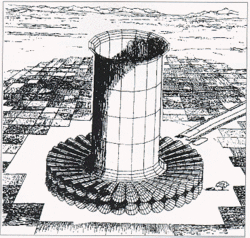Recently, energy towers have been back in the hype cycle, specifically with the misnamed Solar Wind Energy Tower which is actually a downdraft tower which has nothing to do with solar power.

There are two variants of energy towers: water evaporation driven downdraft and solar updraft towers. Both propose tall hollow towers to create movement of air past embedded wind turbines at sufficient velocity to generate electricity.
The premise for the downdraft tower is that you pump a lot of water to the top of a very tall tower, spray it out as a fine mist to cool the air and cause it to become heavier and fall down into the tower, driving a turbine or turbines at the base of the tower.
This is a closely related cousin of the solar updraft tower, which uses the sun’s heat to warm air at the base of the tower under a very wide, canopy, causing it to rise up the tower and drive a bunch of turbines on the way.

Will either of these towers work at all?
Of course they will. The physics are simple, well understood and easy to exploit as stated. Mists of water cause air to cool and sink. Heat causes air to rise. Fiddling with the parameters of amount of water, height of tower and diameter of sun collector will create usable amounts of electricity.
But that’s a bit of a cakewalk. All of the wind energy innovations listed in my post on Good and bad bets: new wind technologies rated will generate electricity as well.
However, let’s take the subtler definition of feasibility.
Will it generate sufficient electricity to make it competitive with other generation technologies.
For the downdraft energy tower, here are the challenges:
1.Essentially, you are taking a water-free form of generation — wind energy — and requiring the use of amounts of water likely equivalent to thermal generation. This requires a large source of water, pumps, etc. The water has to be strained of detritus in order that it can be misted at the top. Sea water would be corrosive, incurring more engineering and maintenance.
2.In order for this to work well, the tower has to be quite high. This means that you have to pump very heavy water a long way up, which requires significant amounts of energy. I won’t bother doing the math, but the Wikipedia reference indicates that calculations showed 50% of the energy produced would be used to pump water.
3.Laminar turbulence loss of energy in devices like this is always much higher in reality than models and simulations account for. They don’t get the energy out that calculations suggest that they will. This means that pumping water would likely take a lot more than 50% of the energy produced.
4.This technology would have to compete with a modern wind turbine which just basically sits there requiring no water and much, much less maintenance.
For the updraft solar energy tower, here are the challenges:
1.You have to cover a very large surface area — 20 square kilometers for 100 MW — with solar thermal collector in order to create the updraft. This area is rendered unusable for anything else and will pretty much bake the ground underneath. Consider a moderate case for normal wind turbine technology. This would require about 80 3 MW wind turbines at a very achievable 40% capacity factor which would fit in the same area of land without impacting one another but only take up <1% to 2% maximum of the total surface area, allowing the land in between to be used for grazing, crops, hiking, archery practice or just sitting there being green and producing oxygen.
2.Once again, the tower has to be fairly high in order to maximize the temperature differential and hence the velocity of the air. This is much less of a concern than on the downdraft tower, because it’s just a tall tower and you aren’t pumping water to the top.
3.Unlike the downdraft tower, this version only works when the sun is shining, which makes the pumping water problem a bit of a wash.
4.Laminar turbulence loss of energy in devices like this is always much higher in reality than models and simulations account for. They don’t get the energy out that calculations suggest that they will. While they project very high efficiencies, the reality just won’t pan out. Ask a fluid dynamics geek for the variances between simulation and reality in this space sometime; it’s enlightening even as your eyes cross.
5.This technology would have to compete with a modern wind turbine which just basically sits there requiring no water and much, much less maintenance or a modern solar farm, which uses photovoltaic panels to directly turn sunlight into electricity with much less construction and fuss.
So there are some challenges which make it unlikely that this technology will be competitive. What do I think is the trump reason for these not generating electricity in any competitive way?
No one has bothered to build any except for prototypes which have been abandoned.
Smart people reinvent variations of these things fairly often. People get enthused about them, get people to invest, build prototypes which don’t work as hoped. The prototypes get abandoned and hopefully get torn down. There are a few around, and they pop up in speculative fiction occasionally, but they just aren’t economically viable in reality.
Source: Barnard On Wind. Reproduced with permission.










